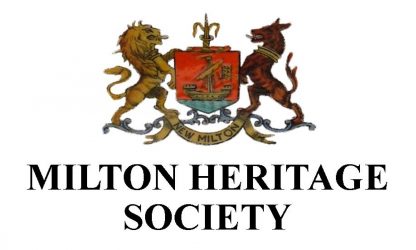On the western cliff tops at Barton on Sea near to the present day Cliff House Hotel used to be a large house which was built in about 1895 as a school for boys. In the early days of its existence the building was known as Hengistbury School, later renamed as Rothsey.

Milton Heritage Society Collection
The school was increased in size by building wings either side of the main building. In 1913 the school was taken over by two sisters, Misses Butterworth, who turned it into a girl’s establishment. They renamed it Barton Court School.

This photograph of a dormitory gives some idea of the style of accommodation and the size of the rooms in the house. In World War One the school was commandeered and incorporated into an army convalescent camp which appears to have taken over a large amount of the Barton cliff top area.
Post war the girls’ school returned for a brief period before reverting to a boy’s establishment in 1924. By the 1930s the building had become the Barton House Hotel, (phone number New Milton 123) which offered relaxing holidays with a sea view. War once again intervened and the building was requisitioned by the army.
At the end of WW2 Barton House was used as a rest home for retired nurses. In 1954 it was purchased by Dame May Curwen who in 1951 founded the British Council for Aid to Refugees (BCAR).

This later merged with another likeminded charity and they became the British Council for Aid to Refugees. BCAR sought to clear the wartime refugee camps in Europe and care for the victims of the Hungarian communist takeover. In addition they also sought to house those people who had fled Russia, Poland, East Germany and Czechoslovakia, the Baltic States and other parts of Eastern Europe.
Many of the people who came to Barton House were sent there from all over the UK. Their stay was sponsored by charities such as the Rotary Club, or by churches of all denominations. Initially the sponsorship per person was for seven years. This was later extended to sixteen.
The refugees often had very little in the way of personal possessions with them. What few items they had were kept safely in their rooms and jealously guarded. Many people had lost everything when they left their homeland and had to start again on reaching Britain.
During their working lives in the UK the residents took on all forms of employment including farming, interpreting and working in mental health hospitals. Mr Ivan Sherbakov, was a Russian lawyer who fled the revolution. He spoke five languages including Esperanto and ended up teaching Russian at Brockenhurst Grammar School. In addition he was an accomplished poet whose work was published in 1973 in the book Contemporary Poets.
Other stories behind some of the residents are just as fascinating. Baroness Vera Dukshta-Dukshinska had fled the Russian Revolution. Initially she lived in Yugoslavia but when that country became communist under Marshal Tito, she moved to England and ended up at Barton House. She spoke in French which was the first language of Russian nobility, and also spoke Russian, Serbian, German and just a little English.
With language difficulties and the mental scars the residents had accumulated during their traumatic lives, Barton House was virtually a closed community. Offers of friendship were made to the home by Bournemouth based German Lutherans. The Methodist Church in New Milton managed to build a relationship with the residents. The residents had their own orthodox chapel which was for many years run by Mr Ivan Maluka who had lived at Barton House since it first opened. He had also fled from Russia. Once a year they held a fete in the grounds of the house. However, even then the residents preferred to be alone with their thoughts.
Barton House was run for many years by Mrs Erika Sivi, an Estonain refugee.

Courtesy of Sally Brownson
She had worked post war in Germany in camps for displaced person. She came to England in 1947 as a voluntary worker in the Westward Ho! refugee aid scheme. Mrs Sivi made sure that Barton House was a home and not an institution. In an interview in 1979 Erika said of her residents “They don’t forget the past and the scars are still there”
Also caring for the residents was Sister Elizabeth Balaam. She looked after their medical needs for twelve years before ill health forced her to retire. Sally Brownson worked for twelve years as the cook at Barton House and I am grateful to her for providing a lot of information about the premises.

Courtesy of Sally Brownson
In 1991 Barton House closed down. The residents, now quite elderly were moved on to other care homes. The numbers of eastern European refugees had been falling for some time. In addition it was becoming increasingly more expensive to maintain and modernise such an old house. The building lay empty and was boarded up for several years before it was demolished. A block of flats and some cottages were built on the site retaining the name, Barton House.
For some 37 years Barton House was a home and Barton on Sea a haven to many people who had fled their homeland.
